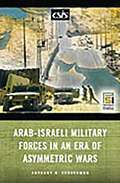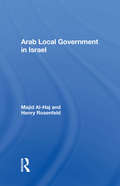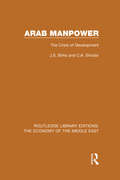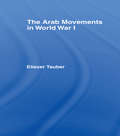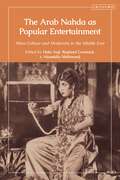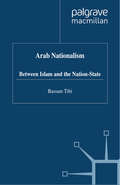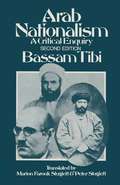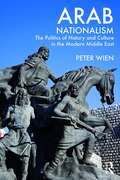- Table View
- List View
The Arab-israeli Conflict (PDF)
by Tony McaleavyA range of textbooks covering many of the options available on GCSE history specifications. The Arab-Israeli Conflict is full colour throughout, highly illustrated and include a range of activities to motivate students.
The Arab-Israeli Conflict, Volume IV, Part I: The Difficult Search for Peace (1975-1988)
by John Norton MooreVolume IV of The Arab-Israeli Conflict is a fundamental research tool for students of the Middle East and for those responsible for U.S. policy-making in that area. It is a successor to John Norton Moore's widely acclaimed three-volume compilation of readings and documents on international law and the Arab-Israeli conflict and to the one-volume abridged edition of that compilation, published by Princeton University Press in 1974 and 1977 respectively. Additionally, Volume IV stands on its own as a documentary history of the period from the September 1975 Sinai accords through the Shultz peace initiative and the Palestinian uprising in December 1988.Originally published in 1991.The Princeton Legacy Library uses the latest print-on-demand technology to again make available previously out-of-print books from the distinguished backlist of Princeton University Press. These editions preserve the original texts of these important books while presenting them in durable paperback and hardcover editions. The goal of the Princeton Legacy Library is to vastly increase access to the rich scholarly heritage found in the thousands of books published by Princeton University Press since its founding in 1905.
The Arab-Israeli Conflict, Volume IV, Part II: The Difficult Search for Peace (1975-1988)
by John Norton MooreThe Arab Israeli Conflict is a fundamental research tool for students of the Middle East and for those responsible for U.S. policymaking in that area. It is a successor to John Norton Moore's widely acclaimed three-volume compilation of readings and documents on international law and the Arab Israeli conflict.Originally published in 1991.The Princeton Legacy Library uses the latest print-on-demand technology to again make available previously out-of-print books from the distinguished backlist of Princeton University Press. These editions preserve the original texts of these important books while presenting them in durable paperback and hardcover editions. The goal of the Princeton Legacy Library is to vastly increase access to the rich scholarly heritage found in the thousands of books published by Princeton University Press since its founding in 1905.
Arab-Israeli Military Forces in an Era of Asymmetric Wars (Praeger Security International)
by Anthony H. CordesmanThe reality of the Arab-Israeli balance now consists of two subordinate balances: Israel versus Syria and Israel versus the Palestinians. The book analyzes these two balances in detail and their impact on defense planning in each country and on the overall strategic risk to the region as a whole. It covers military developments in each of six states-Egypt, Israel, Jordan, Lebanon, Syria, and Palestine-and provides an analytical view with charts and tables of how the changing natures of the military and political threats faced by each is impacting its military force readiness and development. The book has the most comprehensive data on past, current, and future military force structure currently available, drawn from the widest range of sources.Responding to the most recent of events in the region, this book is the first to deal with the effects on the Arab-Israeli military balance of the strategic uncertainty created by the Iraqi insurgency and the Iranian nuclear program. It also studies how the Gaza pullout, the Syrian withdrawal from Lebanon, the changing political landscape in Israel, and the threat of nuclear proliferation are having impacts on the Egyptian-Israeli and Jordanian-Israeli peace accords and the prospects for a settlement between the Palestinians and Israelis. The roles of Hezbollah, Hamas, and Palestinian Islamic Jihad are analyzed in light of the changing political landscape in both Israel and Palestine. Given the role of Syria in the Palestinian-Israeli affairs, the book also explores the ways that internal instability in Lebanon could escalate into a regional conflict.
Arab-Jewish Activism in Israel-Palestine
by Marcelo SvirskyApplying the insights of Deleuze and Guattari's works to Israel-Palestine, Arab-Jewish Activism in Israel-Palestine sets out to re-conceptualise the relationship between resistance and power in ethnically segregated spaces in general, and the Israeli-Palestine context in particular. Combining many years of ethnographic study and political and social activism with a solid, theoretical, conceptual framework, Marcelo Svirsky convincingly argues that successful efforts to decolonise the region depend on taking the struggle beyond self-determination and making it collaborative. Decolonisation depends on political and cultural changes that elaborate on the historical partition of social life in the region that have been an issue since the early twentieth century. This elaboration means producing a civil struggle aimed at the destabilisation of the Zionist supremacy and resulting in a democratic, political community from the Mediterranean Sea to the Jordan River. Simply not just another book on Israel and Palestine, Arab-Jewish Activism in Israel-Palestine provides refreshingly new empirical evidence and theoretical analysis on the connection between resistance, intercultural alliances, civil society, and the potential for actualising shared sociabilities in a conflict-ridden society. An indispensable read to all scholars wishing to gain original insights into the transversal connections which transcend ethnicity.
Arab-Jewish Activism in Israel-Palestine
by Marcelo SvirskyApplying the insights of Deleuze and Guattari's works to Israel-Palestine, Arab-Jewish Activism in Israel-Palestine sets out to re-conceptualise the relationship between resistance and power in ethnically segregated spaces in general, and the Israeli-Palestine context in particular. Combining many years of ethnographic study and political and social activism with a solid, theoretical, conceptual framework, Marcelo Svirsky convincingly argues that successful efforts to decolonise the region depend on taking the struggle beyond self-determination and making it collaborative. Decolonisation depends on political and cultural changes that elaborate on the historical partition of social life in the region that have been an issue since the early twentieth century. This elaboration means producing a civil struggle aimed at the destabilisation of the Zionist supremacy and resulting in a democratic, political community from the Mediterranean Sea to the Jordan River. Simply not just another book on Israel and Palestine, Arab-Jewish Activism in Israel-Palestine provides refreshingly new empirical evidence and theoretical analysis on the connection between resistance, intercultural alliances, civil society, and the potential for actualising shared sociabilities in a conflict-ridden society. An indispensable read to all scholars wishing to gain original insights into the transversal connections which transcend ethnicity.
The Arab Lands under Ottoman Rule: 1516–1800 (A History of the Near East)
by Jane HathawayThe Arab Lands under Ottoman Rule assesses the effects of Ottoman rule on the Arab Lands of Egypt, Greater Syria, Iraq, and Yemen between 1516 and 1800. Drawing attention to the important history of these regions, the book challenges outmoded perceptions of this period as a demoralizing prelude to the rise of Arab nationalism and Arab nation-states in the nineteenth and twentieth centuries. As well as exploring political events and developments, it delves into the extensive social, cultural, and economic changes that helped to shape the foundations of today's modern Middle and Near East. In doing so, it provides a detailed view of society, incorporating all socio-economic classes, as well as women, religious minorities, and slaves. This second edition has been significantly revised and updated and reflects the developments in research and scholarship since the publication of the first edition. Engaging with a wide range of primary sources and enhanced by a variety of maps and images to illustrate the text, The Arab Lands under Ottoman Rule is a unique and essential resource for students of early modern Ottoman history and the early modern Middle East.
The Arab Lands under Ottoman Rule: 1516–1800 (A History of the Near East)
by Jane HathawayThe Arab Lands under Ottoman Rule assesses the effects of Ottoman rule on the Arab Lands of Egypt, Greater Syria, Iraq, and Yemen between 1516 and 1800. Drawing attention to the important history of these regions, the book challenges outmoded perceptions of this period as a demoralizing prelude to the rise of Arab nationalism and Arab nation-states in the nineteenth and twentieth centuries. As well as exploring political events and developments, it delves into the extensive social, cultural, and economic changes that helped to shape the foundations of today's modern Middle and Near East. In doing so, it provides a detailed view of society, incorporating all socio-economic classes, as well as women, religious minorities, and slaves. This second edition has been significantly revised and updated and reflects the developments in research and scholarship since the publication of the first edition. Engaging with a wide range of primary sources and enhanced by a variety of maps and images to illustrate the text, The Arab Lands under Ottoman Rule is a unique and essential resource for students of early modern Ottoman history and the early modern Middle East.
The Arab Lands under Ottoman Rule: 1516-1800
by Jane Hathaway Karl BarbirIn this seminal study, Jane Hathaway presents a wide-ranging reassessment of the effects of Ottoman rule on the Arab Lands of Egypt, Greater Syria, Iraq and Yemen - the first of its kind in over forty years. Challenging outmoded perceptions of this period as a demoralizing prelude to the rise of Arab nationalism and Arab nation-states in the nineteenth and twentieth centuries, Hathaway depicts an era of immense social, cultural, economic and political change which helped to shape the foundations of today's modern Middle and Near East. Taking full advantage of a wide range of Arabic and Ottoman primary sources, she examines the changing fortunes of not only the political elite but also the broader population of merchants, shopkeepers, peasants, tribal populations, religious scholars, women, and ethnic and religious minorities who inhabited this diverse and volatile region. With masterly concision and clarity, Hathaway guides the reader through all the key current approaches to and debates surrounding Arab society during this period. This is far more than just another political history; it is a global study which offers an entirely new perspective on the era and region as a whole.
The Arab Lands under Ottoman Rule: 1516-1800
by Jane Hathaway Karl BarbirIn this seminal study, Jane Hathaway presents a wide-ranging reassessment of the effects of Ottoman rule on the Arab Lands of Egypt, Greater Syria, Iraq and Yemen - the first of its kind in over forty years. Challenging outmoded perceptions of this period as a demoralizing prelude to the rise of Arab nationalism and Arab nation-states in the nineteenth and twentieth centuries, Hathaway depicts an era of immense social, cultural, economic and political change which helped to shape the foundations of today's modern Middle and Near East. Taking full advantage of a wide range of Arabic and Ottoman primary sources, she examines the changing fortunes of not only the political elite but also the broader population of merchants, shopkeepers, peasants, tribal populations, religious scholars, women, and ethnic and religious minorities who inhabited this diverse and volatile region. With masterly concision and clarity, Hathaway guides the reader through all the key current approaches to and debates surrounding Arab society during this period. This is far more than just another political history; it is a global study which offers an entirely new perspective on the era and region as a whole.
Arab Liberal Thought after 1967: Old Dilemmas, New Perceptions
by Meir Hatina Christoph SchumannThis volume aims at confronting the image of the Middle East as a region that is fraught with totalitarian ideologies, authoritarianism and conflict. It gives voice and space to other, more liberal and adaptive narratives and discourses that endorse the right to dissent, question the status quo, and offer alternative visions for society.
Arab Local Government In Israel
by Majid Al-hajA study in the project The Status and Condition of the Arabs in Israel under the direction of Professor Henry Rosenfeld. In this book the authors present a historical analysis of local authorities in Arab communities prior to and since the establishment of the state of Israel. They discuss the workings of Arab local councils, municipalities, and national political groupings as well as the circumstances of internal conflicts in Arab settlements. They also present comparative data on budgets in Jewish and Arab communities.
Arab Local Government In Israel
by Majid Al-hajA study in the project The Status and Condition of the Arabs in Israel under the direction of Professor Henry Rosenfeld. In this book the authors present a historical analysis of local authorities in Arab communities prior to and since the establishment of the state of Israel. They discuss the workings of Arab local councils, municipalities, and national political groupings as well as the circumstances of internal conflicts in Arab settlements. They also present comparative data on budgets in Jewish and Arab communities.
Arab Manpower (RLE Economy of Middle East): The Crisis of Development
by J.S. Birks C.A. SinclairThe Arab world increasingly falls into two divisions, the capital-poor and the capital-rich countries (where capital means, in essence, oil). In the capital-rich countries shortage of labour is the chief constraint on growth. In the capital-poor countries analysis of the labour market is equally central, as shortage of labour compounds the already existing problem of shortage of capital. This book surveys the labour markets of the Arab world state by state, evaluating them by demand and supply analysis, and analysing the different elements in trends of employment. It forecasts the areas of stress in the next decade and suggests ways of minimising them. The book, based on much previously unpublished information and on extensive on-the-spot research in the respective Arab countries, sets out the economic and social conditions which underly the impending crisis of development in the Arab region.First published in 1980.
Arab Manpower (RLE Economy of Middle East): The Crisis of Development
by J.S. Birks C.A. SinclairThe Arab world increasingly falls into two divisions, the capital-poor and the capital-rich countries (where capital means, in essence, oil). In the capital-rich countries shortage of labour is the chief constraint on growth. In the capital-poor countries analysis of the labour market is equally central, as shortage of labour compounds the already existing problem of shortage of capital. This book surveys the labour markets of the Arab world state by state, evaluating them by demand and supply analysis, and analysing the different elements in trends of employment. It forecasts the areas of stress in the next decade and suggests ways of minimising them. The book, based on much previously unpublished information and on extensive on-the-spot research in the respective Arab countries, sets out the economic and social conditions which underly the impending crisis of development in the Arab region.First published in 1980.
Arab Media Systems (Global Communications #3)
by Carola Richter and Claudia KozmanThis volume provides a comparative analysis of media systems in the Arab world, based on criteria informed by the historical, political, social, and economic factors influencing a country’s media. Reaching beyond classical western media system typologies, 'Arab Media Systems' brings together contributions from experts in the field of media in the Middle East and North Africa (MENA) to provide valuable insights into the heterogeneity of this region’s media systems. It focuses on trends in government stances towards media, media ownership models, technological innovation, and the role of transnational mobility in shaping media structure and practices. Each chapter in the volume traces a specific country’s media – from Lebanon to Morocco – and assesses its media system in terms of historical roots, political and legal frameworks, media economy and ownership patterns, technology and infrastructure, and social factors (including diversity and equality in gender, age, ethnicities, religions, and languages). This book is a welcome contribution to the field of media studies, constituting the only edited collection in recent years to provide a comprehensive and systematic overview of Arab media systems. As such, it will be of great use to students and scholars in media, journalism and communication studies, as well as political scientists, sociologists, and anthropologists with an interest in the MENA region. This volume provides a comparative analysis of media systems in the Arab world, based on criteria informed by the historical, political, social, and economic factors influencing a country’s media. Reaching beyond classical western media system typologies, Arab Media Systems brings together contributions from experts in the field of media in the Middle East and North Africa (MENA) to provide valuable insights into the heterogeneity of this region’s media systems. It focuses on trends in government stances towards media, media ownership models, technological innovation, and the role of transnational mobility in shaping media structure and practices. Each chapter in the volume traces a specific country’s media – from Lebanon to Morocco – and assesses its media system in terms of historical roots, political and legal frameworks, media economy and ownership patterns, technology and infrastructure, and social factors (including diversity and equality in gender, age, ethnicities, religions, and languages). This book is a welcome contribution to the field of media studies, constituting the only edited collection in recent years to provide a comprehensive and systematic overview of Arab media systems. As such, it will be of great use to students and scholars in media, journalism and communication studies, as well as political scientists, sociologists, and anthropologists with an interest in the MENA region. This volume provides a comparative analysis of media systems in the Arab world, based on criteria informed by the historical, political, social, and economic factors influencing a country’s media. Reaching beyond classical western media system typologies, Arab Media Systems brings together contributions from experts in the field of media in the Middle East and North Africa (MENA) to provide valuable insights into the heterogeneity of this region’s media systems. It focuses on trends in government stances towards media, media ownership models, technological innovation, and the role of transnational mobility in shaping media structure and practices. Each chapter in the volume traces a specific country’s media – from Lebanon to Morocco – and assesses its media system in terms of historical roots, political and legal frameworks, media economy and ownership patterns, technology and infrastructure, and social factors (including diversity and equality in gender, age, ethnicities, religions, and languages). This book is a welcome contribution to the field of media studies, constituting the only edited collection in recent years to provide a comprehensive and systematic overview of Arab media systems. As such, it
The Arab Movements in World War I
by Eliezer TauberThis study surveys the many revolutionary attempts carried out against the Ottoman Empire in the Fertile Cresecnt and the Arabian Peninsula during World War I. Special emphasis is laid upon the subversive activities of the Arab secret societies which preceded the outbreak of Sharif Husayn's Arab revolt in 1916. The revolt is thoroughly examined and analyzed, regarding both its military operations and its human composition, which influenced its course.
The Arab Movements in World War I
by Eliezer TauberThis study surveys the many revolutionary attempts carried out against the Ottoman Empire in the Fertile Cresecnt and the Arabian Peninsula during World War I. Special emphasis is laid upon the subversive activities of the Arab secret societies which preceded the outbreak of Sharif Husayn's Arab revolt in 1916. The revolt is thoroughly examined and analyzed, regarding both its military operations and its human composition, which influenced its course.
The Arab Nahda as Popular Entertainment: Mass Culture and Modernity in the Middle East
by Hala Auji Raphael Cormack Alaaeldin MahmoudWhat was popular entertainment like for everyday Arab societies in Middle Eastern cities during the long nineteenth century? In what ways did café culture, theatre, illustrated periodicals, cinema, cabarets, and festivals serve as key forms of popular entertainment for Arabic-speaking audiences, many of whom were uneducated and striving to contend with modernity's anxiety-inducing realities? Studies on the 19th to mid-20th century's transformative cultural movement known as the Arab nahda (renaissance), have largely focussed on concerns with nationalism, secularism, and language, often told from the perspective of privileged groups. Highlighting overlooked aspects of this movement, this book shifts the focus away from elite circles to quotidian audiences. Its ten contributions range in scope, from music and visual media to theatre and popular fiction. Paying special attention to networks of movement and exchange across Arab societies in Lebanon, Syria, Egypt, Iraq, and Morocco, this book heeds the call for 'translocal/transnational' cultural histories, while contributing to timely global studies on gender, sexuality, and morality. Focusing on the often-marginalized frequenters of cafés, artist studios, cinemas, nightclubs, and the streets, it expands the remit of who participated in the nahda and how they did.
The Arab Nahda as Popular Entertainment: Mass Culture and Modernity in the Middle East
by Hala Auji Raphael Cormack Alaaeldin MahmoudWhat was popular entertainment like for everyday Arab societies in Middle Eastern cities during the long nineteenth century? In what ways did café culture, theatre, illustrated periodicals, cinema, cabarets, and festivals serve as key forms of popular entertainment for Arabic-speaking audiences, many of whom were uneducated and striving to contend with modernity's anxiety-inducing realities? Studies on the 19th to mid-20th century's transformative cultural movement known as the Arab nahda (renaissance), have largely focussed on concerns with nationalism, secularism, and language, often told from the perspective of privileged groups. Highlighting overlooked aspects of this movement, this book shifts the focus away from elite circles to quotidian audiences. Its ten contributions range in scope, from music and visual media to theatre and popular fiction. Paying special attention to networks of movement and exchange across Arab societies in Lebanon, Syria, Egypt, Iraq, and Morocco, this book heeds the call for 'translocal/transnational' cultural histories, while contributing to timely global studies on gender, sexuality, and morality. Focusing on the often-marginalized frequenters of cafés, artist studios, cinemas, nightclubs, and the streets, it expands the remit of who participated in the nahda and how they did.
Arab Nationalism: Between Islam and the Nation-State
by B. TibiThe third edition includes a new Part Five on the tensions between Arab nationalism and Islam arising from the crisis of the nation-state and of the de-legitimisation of Pan-Arab regimes. The effects of the Arab defeat in the Six-Day War 1967 and the rise of political Islam in the 1970s are the focus of the new part. The background of the analysis of the impact and function of nationalism and its contribution to social and political change in the Third World, taking the rise of nationalism in the Middle East as a historical example. Professor Tibi concentrates on the period after the First World War, when many Arab intellectuals became disillusioned with Britain and France as a result of the occupation of their countries. One focus of this study are the writings and influence of Sati' al-Husri on Middle Eastern politics. Professor Tibi illustrates the connection between modern Arab nationalism and nineteenth-century German Romantic nationalism, which will be of particular interest to the English reader. Professor Tibi concludes that while nationalism has played a necessary and important role in the movement for national independence in the Middle East, it has since developed into an ideology which seems to obstruct further social and political emancipation. This third edition, brought completely up to date by a substantial new introduction and two new concluding chapters, will be of particular interest to historians and social scientists dealing with nationalism and crises of the nation-state as well as to students of the Middle East and contemporary Islam.
Arab Nationalism: A Critical Enquiry
by B. Tibi ed trans Marion Farouk-Sluglett Peter SluglettIn this new edition Professor Tibi analyses the impact and function of nationalism and its contribution to social and political change in the Third World, taking the rise of nationalism in the Middle East as a historical example. He concentrates on the period after the First World War, when many Arab intellectuals became disillusioned with Britain and France as a result of the occupation of their countries. Professor Tibi's careful study of the writings and influence of Sati' al-Husri illustrates the connection between modern Arab nationalism and nineteenth century German Romantic nationalism, which will be of particular interest to the English reader. Professor Tibi concludes that while nationalism has played a necessary and important role in the movement for national independence in the Middle East, it has since developed into an ideology which seems to obstruct further social and political emancipation. This book will be of particular interest to historians and social scientists as well as to specialists in the area itself.
Arab Nationalism: The Politics of History and Culture in the Modern Middle East
by Peter WienArab nationalism has been one of the dominant ideologies in the Middle East and North Africa since the early twentieth century. However, a clear definition of Arab nationalism, even as a subject of scholarly inquiry, does not yet exist. Arab Nationalism sheds light on cultural expressions of Arab nationalism and the sometimes contradictory meanings attached to it in the process of identity formation in the modern world. It presents nationalism as an experienceable set of identity markers – in stories, visual culture, narratives of memory, and struggles with ideology, sometimes in culturally sophisticated forms, sometimes in utterly vulgar forms of expression. Drawing upon various case studies, the book transcends a conventional history that reduces nationalism in the Arab lands to a pattern of political rise and decline. It offers a glimpse at ways in which Arabs have constructed an identifiable shared national culture, and it critically dissects conceptions about Arab nationalism as an easily graspable secular and authoritarian ideology modeled on Western ideas and visions of modernity. This book offers an entirely new portrayal of nationalism and a crucial update to the field, and as such, is indispensable reading for students, scholars and policymakers looking to gain a deeper understanding of nationalism in the Arab world.
Arab Nationalism: The Politics of History and Culture in the Modern Middle East
by Peter WienArab nationalism has been one of the dominant ideologies in the Middle East and North Africa since the early twentieth century. However, a clear definition of Arab nationalism, even as a subject of scholarly inquiry, does not yet exist. Arab Nationalism sheds light on cultural expressions of Arab nationalism and the sometimes contradictory meanings attached to it in the process of identity formation in the modern world. It presents nationalism as an experienceable set of identity markers – in stories, visual culture, narratives of memory, and struggles with ideology, sometimes in culturally sophisticated forms, sometimes in utterly vulgar forms of expression. Drawing upon various case studies, the book transcends a conventional history that reduces nationalism in the Arab lands to a pattern of political rise and decline. It offers a glimpse at ways in which Arabs have constructed an identifiable shared national culture, and it critically dissects conceptions about Arab nationalism as an easily graspable secular and authoritarian ideology modeled on Western ideas and visions of modernity. This book offers an entirely new portrayal of nationalism and a crucial update to the field, and as such, is indispensable reading for students, scholars and policymakers looking to gain a deeper understanding of nationalism in the Arab world.
Arab Nationalism in the Twentieth Century: From Triumph to Despair
by Adeed DawishaLike a great dynasty that falls to ruin and is eventually remembered more for its faults than its feats, Arab nationalism is remembered mostly for its humiliating rout in the 1967 Six Day War, for inter-Arab divisions, and for words and actions distinguished by their meagerness. But people tend to forget the majesty that Arab nationalism once was. In this elegantly narrated and richly documented book, Adeed Dawisha brings this majesty to life through a sweeping historical account of its dramatic rise and fall. Dawisha argues that Arab nationalism--which, he says, was inspired by nineteenth-century German Romantic nationalism--really took root after World War I and not in the nineteenth century, as many believe, and that it blossomed only in the 1950s and 1960s under the charismatic leadership of Egypt's Gamal 'Abd al-Nasir. He traces the ideology's passage from the collapse of the Ottoman Empire through its triumphant ascendancy in the late 1950s with the unity of Egypt and Syria and with the nationalist revolution of Iraq, to the mortal blow it received in the 1967 Arab defeat by Israel, and its eventual eclipse. Dawisha criticizes the common failure to distinguish between the broader, cultural phenomenon of "Arabism" and the political, secular desire for a united Arab state that defined Arab nationalism. In recent decades competitive ideologies--not least, Islamic militancy--have inexorably supplanted the latter, he contends. Dawisha, who grew up in Iraq during the heyday of Arab nationalism, infuses his work with rare personal insight and extraordinary historical breadth. In addition to Western sources, he draws on an unprecedented wealth of Arab political memoirs and studies to tell the fascinating story of one of the most colorful and significant periods of the contemporary Arab world. In doing so, he also gives us the means to more fully understand trends in the region today.Complete with a hard-hitting new and expanded section that surveys recent nationalism and events in the Middle East, Arab Nationalism in the Twentieth Century tells the fascinating story of one of the most colorful and significant periods in twentieth-century Middle Eastern history.



